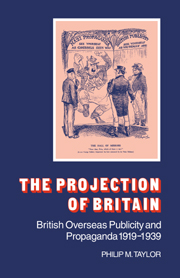Summary
One of the characteristic features of Britain's overseas propaganda between the wars was that it began, almost without exception, as a direct response to the activities of other countries. It was thus, strictly speaking, counter-propagandist in the widest sense. In view of the widespread dislike and suspicion of progaganda, it would not be too unreasonable to suggest that, had the British government been left entirely to its own devices, it would not have embarked upon such work out of preference. This might have been because, as Leeper suspected, new ideas were anathema to the official mind or, as Percy Loraine believed, because of ‘a fundamental English inability to understand the force of ideas and the danger of leaving their shaping in the hands of others’. It may simply have been because of misguided prejudice. It was certainly true that British officials invariably misunderstood what Leeper and his fellow advocates of increased official involvement in propaganda meant by the word in the British context. It was not that the protagonists in the debate failed to explain clearly their interpretation. They did, after all, go to considerable lengths to emphasise the essential differences between British overseas propaganda and that conducted by other governments. It was more a case of the antagonists not being able to accept the idea of propaganda by Britain, even for Britain, as a matter of principle.
- Type
- Chapter
- Information
- The Projection of BritainBritish Overseas Publicity and Propaganda 1919–1939, pp. 293 - 300Publisher: Cambridge University PressPrint publication year: 1981



